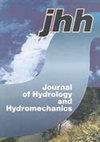Functional evaluation of different soil hydraulic parametrizations in hydrological simulations reveals different model efficiency for soil moisture and water budget
IF 2.4
4区 环境科学与生态学
Q3 WATER RESOURCES
引用次数: 0
Abstract
Novel soil datasets and the application of pedotransfer functions provide soil hydraulic input data for modelling hydrological processes at different scales. We aimed to evaluate the reliability of soil hydraulic parameters derived by indirect methods in simulation of soil moisture time series and water budgets at profile level of three sites (Forest, Orchard and Grassland) from a Central European catchment (Lake Balaton, Hungary). Five soil-vegetation-atmosphere model variants were set up with the Hydrus-1D model for each site, differing only in the parametrization of input soil data: i) a calibrated reference, ii) measured values, iii) values predicted from measured basic soil properties, iv) values predicted from national soil map information, v) values derived from the 3D soil hydraulic dataset of Europe. Calibrated soil parameters led to Nash-Sutcliffe efficiency 0.50, 0.54 and 0.71 for the Forest, Orchard and Grassland Site respectively. The outcomes for model efficiency of soil moisture underline the superiority of local databases over regional ones and the need for more detailed vertical discretization during modelling. The model performance according to soil moisture and water budget accuracy led to different rank order of model variants. Water budget comparisons indicated moderate differences between the hydrologic fluxes simulated by the different model variants, emphasizing the uncertainties associated with soil hydraulic parametrization either at local or at watershed scale.水文模拟中不同土壤水力参数的功能评估揭示了土壤水分和水预算的不同模型效率
新颖的土壤数据集和传粉函数的应用为不同尺度的水文过程建模提供了土壤水力输入数据。我们的目的是评估在模拟中欧集水区(匈牙利巴拉顿湖)三个地点(森林、果园和草地)的土壤水分时间序列和剖面水预算时,通过间接方法得出的土壤水力参数的可靠性。使用 Hydrus-1D 模型为每个地点建立了五个土壤-植被-大气模型变体,其不同之处仅在于输入土壤数据的参数化:i) 校准参考值;ii) 测量值;iii) 根据测量的基本土壤特性预测的值;iv) 根据国家土壤地图信息预测的值;v) 根据欧洲三维土壤水力数据集得出的值。经过校准的土壤参数使森林、果园和草地的纳什-萨特克利夫效率分别达到 0.50、0.54 和 0.71。土壤水分模型效率的结果凸显了地方数据库优于区域数据库,以及在建模过程中需要更详细的垂直离散化。根据土壤水分和水量收支精度对模型进行的性能比较,得出了不同模型变体的排名顺序。水量收支比较表明,不同模型变量模拟的水文通量之间存在一定差异,这强调了与当地或流域尺度的土壤水力参数相关的不确定性。
本文章由计算机程序翻译,如有差异,请以英文原文为准。
求助全文
约1分钟内获得全文
求助全文
来源期刊
CiteScore
4.20
自引率
5.30%
发文量
30
审稿时长
>12 weeks
期刊介绍:
JOURNAL OF HYDROLOGY AND HYDROMECHANICS is an international open access journal for the basic disciplines of water sciences. The scope of hydrology is limited to biohydrology, catchment hydrology and vadose zone hydrology, primarily of temperate zone. The hydromechanics covers theoretical, experimental and computational hydraulics and fluid mechanics in various fields, two- and multiphase flows, including non-Newtonian flow, and new frontiers in hydraulics. The journal is published quarterly in English. The types of contribution include: research and review articles, short communications and technical notes. The articles have been thoroughly peer reviewed by international specialists and promoted to researchers working in the same field.

 求助内容:
求助内容: 应助结果提醒方式:
应助结果提醒方式:


